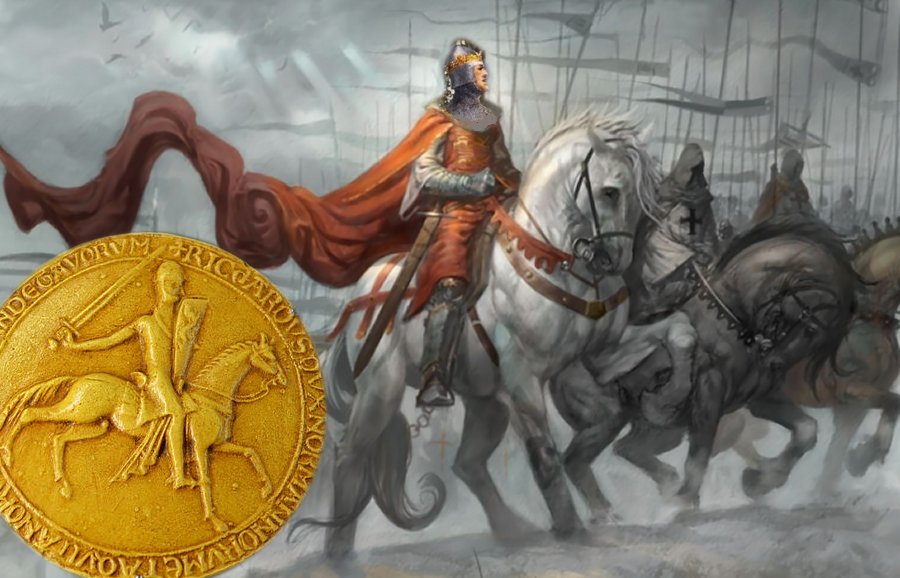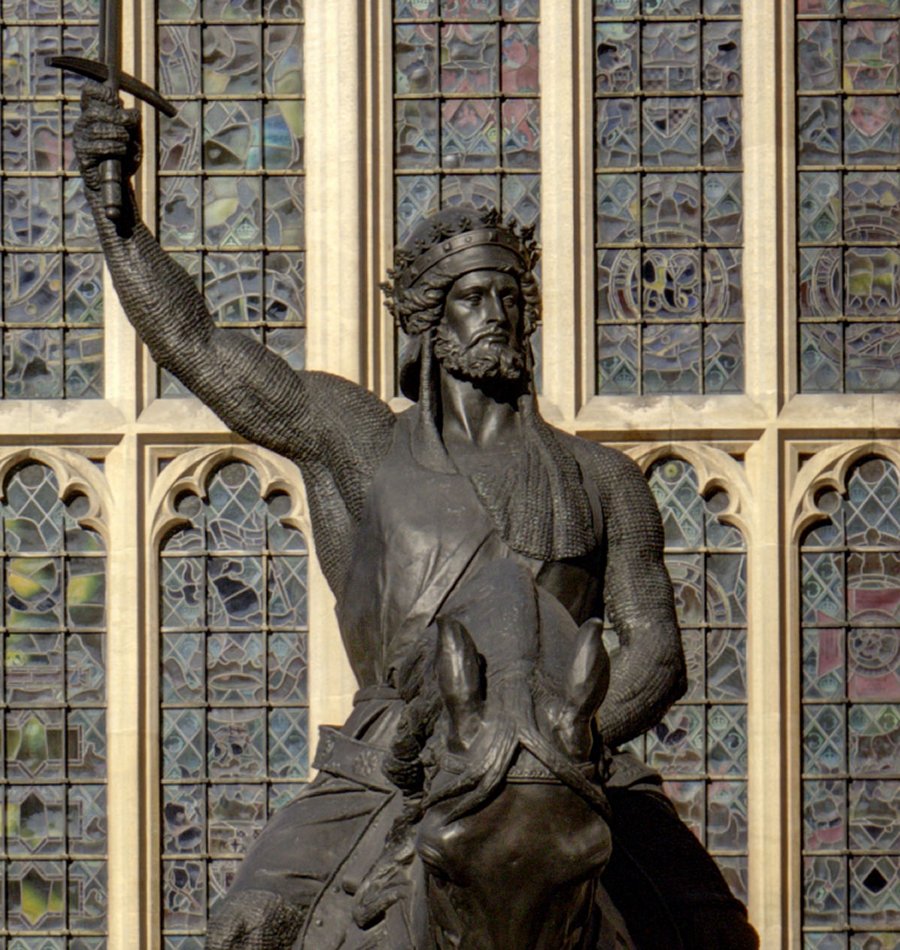Richard The Lionheart: Famous Leader, Warrior And Military Mastermind But Not The Best English King
A. Sutherland - AncientPages.com - Probably the most famous medieval ruler of England - though not the best - was Richard Plantagenet, better known as Richard the Lionheart (“Coeur de Lion”).
Richard has always been portrayed as England’s hero-king, but during his 10-year reign, he spent only six months in England, a mighty but disorganized empire (England and English property in France).
 Richard I, titled Coeur de Lion, (or Lionheart), ascended the British throne, in alliance with King Philip II of France.
Richard I, titled Coeur de Lion, (or Lionheart), ascended the British throne, in alliance with King Philip II of France.
He did not speak English and he was not interested to rule England. He wanted to win the knight’s fame either through rebellion against his own father or participating in a crusade to the Holy Land.
‘I would have sold London itself if I could have found a rich enough buyer,’ he said.
He gained a reputation as a great military leader and warrior; his main ambition was to join the Third Crusade, prompted by Saladin's capture of Jerusalem in 1187. When Richard took the throne it was shortly after Saladin’s capture of Jerusalem in 1187, and preparations were being made for the Third Crusade.
Richard was the son of the mighty King Henry II and the Eleanor of Aquitaine, one of the few women of the Middle Ages who decidedly influenced the fate of the states. The young Richard was brought up in an atmosphere of accusations and grievances between his parents. He also experienced a difficult political situation when the mighty English and French barons were dissatisfied with the strong rule of Plantagenet.
Statue of Richard I, Westminster - front view. Image credit: Prioryman - CC BY-SA 4.0
The family situation changed radically on July 6, 1189; sick and abandoned by all, Richard’s father, Henry II, died.
Richard I, titled Coeur de Lion, (or Lionheart), ascended the British throne, in alliance with King Philip II of France. However, he did not intend to keep up with previous arrangements and refused to pay homage to the British property on the continent. All relations were broken, and a war was imminent. The only help could come from Pope and so it happened. Both monarchs had to conclude an agreement as soon as possible and embark on a crusade.
The Muslims had just taken over Jerusalem.
As soon as Richard had raised an army, he headed for the Holy Land, leaving England in the hands of his mother, Eleanor. In 1190, he departed for the Holy Land to establish bases for crusades in Sicily in 1190 and Cyprus, which he took in 1191.
On 8 June 1191, after landing in Palestine with his ally Philip II of France, he joined the siege of Acre, located in what is now, Akko in Israel.
King Henry II, King Richard the Lionheart and Queen Eleanor of Aquitaine, in Fontevraux Abbey near Chinon, in Anjou, France. (Photographed July 2003) Richard died at Le Château de Châlus Chabrol in Châlus of a crossbow wound. His entrails were buried at the château while his heart was taken to Rouen and the rest of the body to Fontevraud. Image credit: Maksim - Public Domain
Although the conflict had been in progress for two years, Richard moved quickly and he managed to defeat the Muslim defenders within six weeks. When Richard reached Acre, the siege had been going on there for two years. However, the king had not traveled so long-distance for nothing.
He had a plan to quickly overpower Acre, an ancient city dating back thousands of years. This brave and skilled warrior had also the physique of a warrior. At six foot four, Richard towered over others; he was like a giant among ordinary men. The muscles of his strong arms, chest, and back were well developed because he had long practice with the sword and spear.
The arrival of the English king, the legendary Lionheart, with no doubt greatly strengthened
the camp of the besiegers.
In total, during the Third Crusade that lasted from 1191 to 1192, Richard The Lionheart won victories at Cyprus, Acre, and Arsuf (against Saladin), but failed to recover Jerusalem, though he came close to the city.
While returning to the land, the great warrior was captured by the Duke of Austria, who handed him over to the emperor Henry VI. He was held prisoner and later released after a large ransom was paid. Eventually, Richard had to abandon his ambition of taking Jerusalem. In September 1192, Saladin agreed to a three-year truce, which left Acre and a thin coastal strip in the hands of the crusaders.
Richard returned briefly to England, and then he again became engaged in warfare in France. In 1199, while besieging the castle at Châlus, France, Richard was hit in the shoulder by an arrow from a crossbow. Gangrene set in and he died on 6 April, aged 42.
Richard's heart was buried at Rouen in Normandy, France, his entrails in Châlus, where he died, and the rest of his body was buried at the feet of his father at Fontevraud Abbey in Anjou. He left no heir.
Until today, the castle’s fame is associated with the death of King Richard the Lionheart.
Written by – A. Sutherland AncientPages.com Staff Writer
Copyright © AncientPages.com All rights reserved. This material may not be published, broadcast, rewritten or redistributed in whole or part without the express written permission of AncientPages.com
Expand for references
References:
Cawthorne, N. Kings and Queens of England
S. Kay Penman, Lionheart
J. Reston Jr. Warriors of God
More From Ancient Pages
-
 Unique Bronze Age Fortress Discovered In Galway, Ireland
Archaeology | Jun 25, 2022
Unique Bronze Age Fortress Discovered In Galway, Ireland
Archaeology | Jun 25, 2022 -
 Remarkable Discovery Of A 19th-Century Boat Buried Under A Road In St. Augustine, Florida
Archaeology | Oct 16, 2023
Remarkable Discovery Of A 19th-Century Boat Buried Under A Road In St. Augustine, Florida
Archaeology | Oct 16, 2023 -
 A Researcher’s Life’s Work Uncovers First Ancient DNA From Swahili Civilization
Archaeology | Apr 2, 2023
A Researcher’s Life’s Work Uncovers First Ancient DNA From Swahili Civilization
Archaeology | Apr 2, 2023 -
 Krakatoa Prophecy – Samson’s Mysterious Dream
Featured Stories | Aug 6, 2019
Krakatoa Prophecy – Samson’s Mysterious Dream
Featured Stories | Aug 6, 2019 -
 3,000-year-old pottery found in Papua New Guinea’s highlands
News | Sep 3, 2015
3,000-year-old pottery found in Papua New Guinea’s highlands
News | Sep 3, 2015 -
 Unique Sword Casts New Light On Viking Voyages Across The North Sea
Archaeology | Jul 18, 2022
Unique Sword Casts New Light On Viking Voyages Across The North Sea
Archaeology | Jul 18, 2022 -
 Countless Artifacts, Structures And Roads Discovered In Ancient City Of Aigai, Turkey
Archaeology | May 16, 2022
Countless Artifacts, Structures And Roads Discovered In Ancient City Of Aigai, Turkey
Archaeology | May 16, 2022 -
 Roman-Era Girl Buried And Adorned With 1,700-Year Old Gold Jewelry Found In Pagan Cave
Archaeology | Apr 8, 2023
Roman-Era Girl Buried And Adorned With 1,700-Year Old Gold Jewelry Found In Pagan Cave
Archaeology | Apr 8, 2023 -
 Mesopotamian City Jemdet Nasr Dated To 3100–2900 BC: Sophisticated Irrigation Techniques And Earliest Cylinder Seals
Featured Stories | Dec 18, 2016
Mesopotamian City Jemdet Nasr Dated To 3100–2900 BC: Sophisticated Irrigation Techniques And Earliest Cylinder Seals
Featured Stories | Dec 18, 2016 -
 Nurarihyon: Powerful Demon Of Obscure Origin, Chief Of All Yokai
Featured Stories | Nov 6, 2024
Nurarihyon: Powerful Demon Of Obscure Origin, Chief Of All Yokai
Featured Stories | Nov 6, 2024 -
 Cryptic Ice Age Markings In European Caves Deciphered – Proto-Writing Discovered By Amateur Archaeologist
Archaeology | Jan 5, 2023
Cryptic Ice Age Markings In European Caves Deciphered – Proto-Writing Discovered By Amateur Archaeologist
Archaeology | Jan 5, 2023 -
 Head Of The Great Sphinx Was Changed – It’s The Gateway To A Secret Underground City– Historians Suggest
Featured Stories | Jan 20, 2018
Head Of The Great Sphinx Was Changed – It’s The Gateway To A Secret Underground City– Historians Suggest
Featured Stories | Jan 20, 2018 -
 Fascinating 3,000-Year-Old Artifacts Found At Herne Bay, Kent, UK
Archaeology | Jun 24, 2022
Fascinating 3,000-Year-Old Artifacts Found At Herne Bay, Kent, UK
Archaeology | Jun 24, 2022 -
 13th Century Black Book Of Carmarthen: Erased Poetry And Ghostly Faces Revealed By UV Light
Artifacts | Apr 4, 2015
13th Century Black Book Of Carmarthen: Erased Poetry And Ghostly Faces Revealed By UV Light
Artifacts | Apr 4, 2015 -
 Incredible Find – 3,000-Year-Old Canoe Found In Wisconsin’s Lake Mendota
Archaeology | Sep 25, 2022
Incredible Find – 3,000-Year-Old Canoe Found In Wisconsin’s Lake Mendota
Archaeology | Sep 25, 2022 -
 Ancient Mystery Of A Lost Polar Civilization That Vanished Without A Trace
Ancient Mysteries | Dec 27, 2020
Ancient Mystery Of A Lost Polar Civilization That Vanished Without A Trace
Ancient Mysteries | Dec 27, 2020 -
 Oldest Writing System Among Slavs To Be Germanic Runes – New Study
News | Feb 15, 2021
Oldest Writing System Among Slavs To Be Germanic Runes – New Study
News | Feb 15, 2021 -
 Mysterious Scorpion Goddesses In Myths And Legends
Egyptian Mythology | Jan 26, 2016
Mysterious Scorpion Goddesses In Myths And Legends
Egyptian Mythology | Jan 26, 2016 -
 Mystery Greek tomb was dedicated to companion of Alexander – experts say
Civilizations | Oct 1, 2015
Mystery Greek tomb was dedicated to companion of Alexander – experts say
Civilizations | Oct 1, 2015 -
 1,000-Year-Old Coin And Other Finds Unearthed During Excavations At Carrignacurra Castle in Cork
Archaeology | Oct 6, 2022
1,000-Year-Old Coin And Other Finds Unearthed During Excavations At Carrignacurra Castle in Cork
Archaeology | Oct 6, 2022


